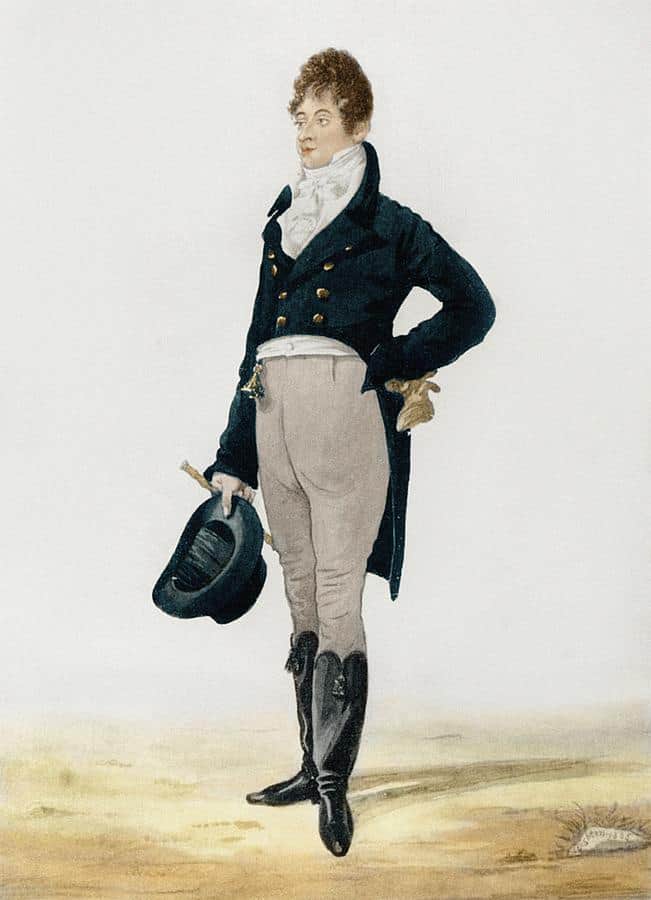Hi there my loves!
It’s me again! Back with some behind the scenes views at the talented hands that crafted our dreamy Regency clothes… But this time, let’s take a look at tailors and men’s clothes!
Not only women shopped in the Regency; men were equally spendthrift.Where the ladies spent their sovereigns on gowns, pelisses, shoes and parasols, the gentlemen laid out even more money on their coats, waistcoats, hats, gloves, boots and other necessities. Beau Brummell decreed what the well dressed man should wear and who could cavil at long trousers, well fitting coats, clean fine linen and elegant waistcoats, topped off with the wonder of wonders – the cravat!

United States, 1792. Public Domain
While women delighted in flimsy fabrics such as muslin and silks, the men had retreated into more somber fabrics of wool and linen. Unless you were a soldier in dress uniform, not an unusual sight during the Napoleonic Wars, gone were the bright, some would say flashy colors of an earlier era. d Coats were preferably made of dark blue, grey, brown or black wool fabric. Merino wool seems to have been especially popular. Bath cloth, or more correctly Bath coating, was a light fabric with a decided nap similar to duffel (as in duffel coat). e Embroidery and silk fabrics only lived on in the waistcoat, which could be a wonder indeed! Out of all this soberness rose the cut as the new god of perfection and wool lent itself to it with vigor and ease.
Men’s wear was indeed tailor made, as were most clothes of the era, with the fit rather than the quality of the fabric the distinguishing mark between the top of the trees dandy and the middle class man on the street. Each tailor had his distinct style of cutting and fitting, hence men’s clothes of the Regency screamed the name of their maker as much as a designer label today.

Beau Brummell giving directions to his tailor.Public Domain.
During the Regency era, London tailors were considered the best in Europe. Any man who was interested in presenting himself as an arbiter of taste, let alone one of the Dandy set, knew he needed to shop in London. Two of the best-known tailors of the day were Schweitzer and Davidson of 12 Cork Street and John Weston, located at 34 Old Bond Street. Weston was known to be the most expensive tailor in London and a favorite of Beau Brummell and the Prince Regent.
Some of the famous tailors of the era we know from letters, memoirs and diary notes, while a few are still in business today.
John Weston, however, was not the only tailor enjoying Brummell’s patronage, as The Beau, at one time or another, bespoke clothes from most of the best tailors of his day. George Stultz, from 1809 established at No 10 Clifford Street, did so well on his fame that when he died in 1833 he had not only been created a peer but worth half a million pounds! g The estimable Schweitzer & Davison of Cork Street, particularly renowned for the cut of their coats, were also patronized by the Prince of Wales (the future George IV) as was Jonathan Meyer of Conduit Street. I
To Meyer, who had made his uniforms during his brief military stint, Brummell went with his livelier ideas and it is still debated whether it was Brummell or Meyer who invented the fitted trousers that had an opening at the ankle, which closed with buttons. For certain Meyer sewed them and Brummell popularized them. The further improvement of a small strap under the instep contributed to their wrinkle-free appearance.

Caricature of Beau Brummell done as a print by Robert Dighton, 1805. U.S. Public Domain
It is interesting to note that engaging a tailor was not an exclusive male prerogative, as the best also made clothes for women, in particular such clothes as the riding habit, a form fitting garment usually made of wool. Thus Sarah Hutchinson (stuck in the country) wrote her good friend Edward Quillinan in London to commission her a new habit from the celebrated Stultz, sending her old one along to be used as a pattern. This was in 1829 and the tailor charged 10 guineas, excluding fabric, for making a riding habit. k
We keep talking about Weston and Schultz or Nugee as if only the one man was responsible for the creation of these garments but in reality each represented a whole tailor shop that included, besides the owner and his assistant, at least 200-300 journeyman as well as apprentices.
What do you think my dears? Can you even imagine an army of people employed behind each of your garments? I know I can’t…
I hope you enjoyed the article darlings! If you have any questions and/or comments feel free to write to me below!
All my love,
Written byEmma Linfield

 Share this book
Share this book